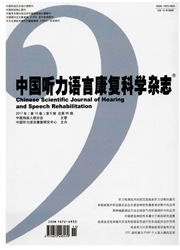

 中文摘要:
中文摘要:
目的 寻找可靠的客观测定方法,在术中即时评价由植入体至听觉中枢传导通路的情况,并在术后协助人工耳蜗编程调试.方法 植入奥地利Combi 40+型人工耳蜗系统的36位患者,使用CI.STUDIO+2.0软件在术中进行电诱发镫骨肌反射(electrically evoked stapedius reflex,ESR)检测,分别选取第1、6、12电极作为观察蜗顶、蜗中、蜗底3个不同部位的研究电极,观察ESR检出率以及镫骨肌反射阈(electrically evoked stapediua reflex threshold,ESRT)与主观阈值(threshold,THR)、最大舒适级(maximum comfortable level,MCL)之间的关系.结果 ESR检出率为69.44%;各电极ESRT远远大于心理物理测试得到的主观阈值,接近最大舒适级,在THR和MCL动态范围的80%~90%左右,均值t检验ESRT与MCL无统计学差异(P〉0.05).结论 ESR既可以用于术中判断植入体是否完好和听觉传导通路是否正常,预测手术效果,又可以在术后协助人工耳蜗编程调试,是一种方便、快捷的客观检查方法.
 英文摘要:
英文摘要:
Objective To explore the reliable and objective methods for assessing the pathway from the cochlear implant to auditory center during the surgery and assisting the mapping after the implantation. Methods The detection rates of the electrically evoked stapedius reflexes (ESR) of 1, 6 and 12 electrode arrays were observed in 36 patients with Combi 40+ cochlear implants. The relationships between the electrically evoked stapedius reflex threshold (ESIRT), threshold (THR) and maximum comfortable level (MCL) were statistically analyzed. Results The detection rate of ESR was 69.44 %. ESRT was at the dynamic range of 80%--90% between THR and MCL, close to MCL. There was no significant difference between ESRT and MCL(P〉0.05). conclusions ESR test can be used to assess the conditions of the cochlear device and the auditory pathway. It is also an efficient and objective way to assist in the mapping of cochlear implant after the surgery.
 同期刊论文项目
同期刊论文项目
 同项目期刊论文
同项目期刊论文
 Adenoviral-mediated Hath1-EGFP gene transfer into guinea pig cochlear through an Intact Round Window
Adenoviral-mediated Hath1-EGFP gene transfer into guinea pig cochlear through an Intact Round Window Chondrocyte-specific Smad4 gene conditional knockout resulting in hearing loss and inner ear malform
Chondrocyte-specific Smad4 gene conditional knockout resulting in hearing loss and inner ear malform 期刊信息
期刊信息
